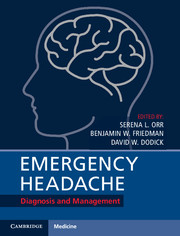Book contents
- Emergency Headache
- Emergency Headache
- Copyright page
- Contents
- Contributors
- Preface
- 1 Introduction
- 2 Epidemiology of Headache in the Emergency Department
- 3 Approach to History Taking and the Physical Examination
- 4 Approach to Investigations
- 5 Thunderclap Headache in the Emergency Department
- 6 Other Secondary Headaches in the Emergency Department
- 7 The Migraine Patient in the Emergency Department
- 8 The Patient with a Trigeminal Autonomic Cephalalgia in the Emergency Department
- 9 Other Primary Headache Disorders That Can Present to the Emergency Department
- 10 Medication Overuse Headache in the Emergency Department
- 11 Approach to the Pediatric Patient with Headache in the Emergency Department
- 12 Approach to Pregnant or Lactating Patients with Headache in the Emergency Department
- 13 Approach to the Elderly Patient with Headache in the Emergency Department
- 14 Preventing Emergency Department Visits in Primary Headache Patients and Prevention of Bounce-Backs to the Emergency Department
- Index
- References
10 - Medication Overuse Headache in the Emergency Department
Published online by Cambridge University Press: 09 October 2017
- Emergency Headache
- Emergency Headache
- Copyright page
- Contents
- Contributors
- Preface
- 1 Introduction
- 2 Epidemiology of Headache in the Emergency Department
- 3 Approach to History Taking and the Physical Examination
- 4 Approach to Investigations
- 5 Thunderclap Headache in the Emergency Department
- 6 Other Secondary Headaches in the Emergency Department
- 7 The Migraine Patient in the Emergency Department
- 8 The Patient with a Trigeminal Autonomic Cephalalgia in the Emergency Department
- 9 Other Primary Headache Disorders That Can Present to the Emergency Department
- 10 Medication Overuse Headache in the Emergency Department
- 11 Approach to the Pediatric Patient with Headache in the Emergency Department
- 12 Approach to Pregnant or Lactating Patients with Headache in the Emergency Department
- 13 Approach to the Elderly Patient with Headache in the Emergency Department
- 14 Preventing Emergency Department Visits in Primary Headache Patients and Prevention of Bounce-Backs to the Emergency Department
- Index
- References
Summary
Medication overuse headache (MOH) is defined as headache occurring on 15 or more days per month developing as a consequence of regular overuse of acute or symptomatic headache medication (on 10 or more, or 15 or more days per month, depending on the medication) for more than three months. Triptans, NSAIDs, acetaminophen, ergotamine, barbiturates, and opioids can all cause MOH. Although the optimal treatment strategy for MOH is debated, treatments include discontinuing the overused medications and treating with preventive migraine medications. In the ED, it is important to recognize patients who have MOH to provide appropriate treatment recommendations for MOH and to avoid perpetuating the patient’s medication overuse. In general, ED treatment of the patient with frequent headaches should not include narcotics or butalbital-containing medications as they are associated with the highest risk of developing MOH as well as the potential to create drug-seeking behavior. Proper follow-up should be arranged prior to discharge from the ED.
- Type
- Chapter
- Information
- Emergency HeadacheDiagnosis and Management, pp. 99 - 109Publisher: Cambridge University PressPrint publication year: 2017

